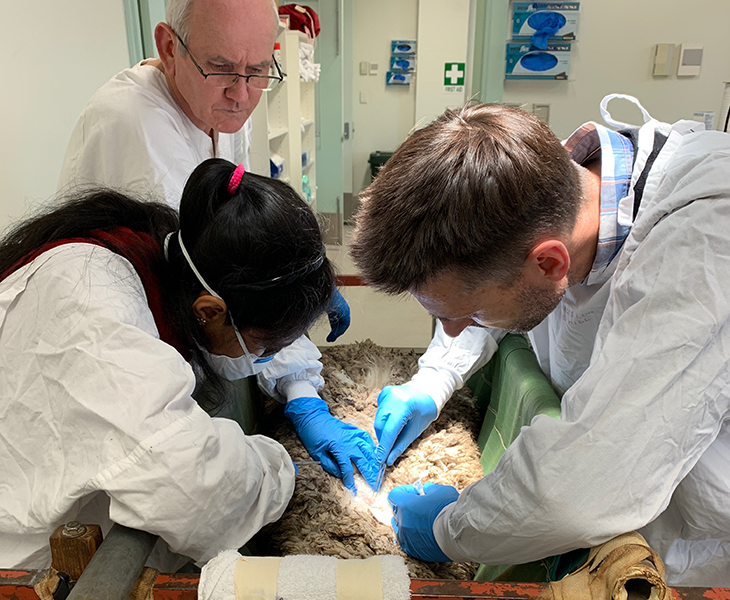CSIRO scientist Tony Vuocolo vaccinating sheep with prototype flystrike vaccines.
AWI is now one year into a major four-year preliminary research project to help develop a commercial vaccine that will protect sheep right across Australia from the Australian sheep blowfly. This $2.5 million collaborative project has achieved much in its first year.
Here, project leaders Tony Vuocolo (CSIRO) and Trent Perry (University of Melbourne) provide woolgrowers with updates on their respective areas of research.
CSIRO RESEARCH UPDATE
KEY POINTS
- CSIRO researchers have identified key proteins in blowfly maggots that are important for their growth and development.
- The team has developed and tested prototype flystrike vaccines that help the sheep's immune system build a defence mechanism (antibodies) that will target and destroy these proteins.
- However, extracting natural larval protein from actual flies for the vaccine is prohibitively expensive commercially, so the team is looking at ways to develop an alternative and cheaper way to synthesise them.
During the past 12 months, CSIRO has been advancing the development of a flystrike vaccine by producing and testing an initial subset of prototype trial vaccines. Results from these trials are helping inform what needs to be done next in producing a viable and affordable flystrike vaccine for the sheep industry.
CSIRO has identified key proteins in blowfly larvae (maggots) that are important for their growth and development. The vaccine, when given to sheep, causes the sheep's immune system to build a defence system in the blood, using weapons called antibodies that will target these key larval proteins. The antibodies react against the larvae when they try to feed on sheep by targeting and interfering with these proteins, resulting in stunted or dead blowfly larvae.
The research initially confirmed that isolating these proteins directly from larvae and using them in a vaccine was highly effective in compromising larval growth and viability. Using this information in combination with the sheep blowfly genome sequence (an outcome from another AWI-funded University of Melbourne project) has allowed the expansion and identification of additional protein-encoding genes that may be used in a vaccine.
It will be prohibitively expensive and require a lot of flies to use the actual proteins extracted from flies themselves. This means we ideally need to develop an alternative cheaper way to synthesise them. However, to generate an effective immune response, the ideal protein antigen(s) for the vaccine must closely resemble the characteristics of the natural larval protein. To do this, antigens are being produced in specialised insect cell systems in the laboratory; in addition, CSIRO is also exploring alternative ways to manufacture key protein associated structures that may be used in a vaccine.
Eight candidate antigens are being trialled currently in prototype vaccines with an additional six in production for testing in the coming several months. The current trials have indicated that special structures associated with these proteins are critical in helping produce an effective immune response that will deleteriously affect larval growth. Ensuring we can retain these structures is the key challenge in producing these complex synthetic antigens.
The next 12 months of research will determine the directions that need to be undertaken to develop an effective flystrike vaccine. Developing a vaccine is difficult but, if successful, will have a huge beneficial impact on the sheep industry. An annual vaccination to help protect sheep from flystrike is the holy grail in flystrike control and remains the key aim of this CSIRO team.
UNIVERSITY OF MELBOURNE RESEARCH UPDATE

University of Melbourne PhD student Gothami Welikadage and scientists Vern Bowles and Trent Perry collecting blowfly larvae from an implanted sheep during their in vivo implant trial.
KEY POINTS
- The University of Melbourne researchers have collected hundreds of blowflies from right across Australia and are studying them
- to identify the regions that flies are moving between and how they adapt to their environment. This information will help inform pest management strategies, such as how to best contain insecticide resistance if it arises.
- Working with CSIRO, the researchers are examining the protein sequence of current vaccine candidate genes to help ensure that the proteins they are targeting are the same in blowfly populations across Australia.






